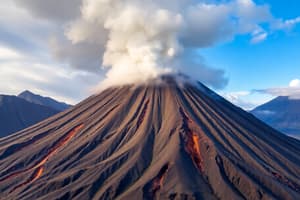Podcast
Questions and Answers
Which of the following characteristics is most indicative of a shield volcano?
Which of the following characteristics is most indicative of a shield volcano?
- Steep slopes and a prominent, narrow crater.
- Broad, slightly domed structure formed by lava flows. (correct)
- Alternating layers of lava and pyroclastic deposits.
- Violent eruptions with pyroclastic flows and tephra
A phreatic eruption involves the interaction of magma with water, creating a violent explosion and fine ash eruption.
A phreatic eruption involves the interaction of magma with water, creating a violent explosion and fine ash eruption.
False (B)
Explain the key difference between magma and lava.
Explain the key difference between magma and lava.
Magma is molten rock located beneath the Earth's surface, while lava is molten rock that has erupted onto the Earth's surface.
A ______ is a large volcanic crater formed by the collapse of a volcano's summit after a major eruption.
A ______ is a large volcanic crater formed by the collapse of a volcano's summit after a major eruption.
Match the volcano type with its description:
Match the volcano type with its description:
Flashcards
Volcano
Volcano
Openings in the Earth's surface that eject molten rocks, smoke, gases, and ashes.
Cinder Cone Volcano
Cinder Cone Volcano
A steep, wide volcano formed from ejected lava fragments, often with a wide crater.
Composite Volcano
Composite Volcano
Also known as stratovolcano, it has layers of lava and pyroclastic deposits, forming a nearly perfect slope.
Plinian Eruption
Plinian Eruption
Signup and view all the flashcards
Active vs Inactive Volcanoes
Active vs Inactive Volcanoes
Signup and view all the flashcards
Study Notes
Introduction
- This video is about volcanoes, specifically the different types of volcanoes and volcanic eruptions.
What is a Volcano?
- Volcanoes are openings in the Earth's surface where molten rocks, smoke, gases, and ashes are ejected.
- They have three basic parts: the base, the slope, and the summit (where the crater is located).
- A crater is a funnel-shaped depression at the top of a volcano, formed by explosive eruptions.
- A caldera is a large volcanic crater formed when the wall of the crater collapses after an explosive eruption.
- Magma is molten rock found below or within the Earth's crust.
- Lava is molten rock that has been ejected from a volcano.
Types of Volcanoes
- Volcanoes are classified by their shape and eruption type.
Volcanoes Classified by Shape
- Shield Volcano: Formed by the accumulation of lava flows.
- Has a broad, slightly domed structure that resembles a warrior's shield.
- Example: Mauna Loa in Hawaii.
- Cinder Cone Volcano: Formed from ejected lava fragments.
- Has a steep slope, wide crater, and is the most abundant type of volcano.
- Example: Mount Paricutin in Mexico.
- Composite Volcano (Stratovolcano): Formed by alternating layers of lava and pyroclastic deposits.
- Has a large, nearly perfect slope structure.
- Example: Mayon Volcano in the Philippines.
Volcanoes Classified by Eruption Type
- Phreatic: A steam-driven eruption caused by hot rocks coming into contact with water; also known as hydrothermal eruptions.
- Example: Taal Volcano in the Philippines (January 12, 2020).
- Phreatomagmatic: A violent eruption due to the interaction of water and magma, producing a fine ash eruption.
- Strombolian: A periodic, weak to violent eruption characterized by lava fountains.
- Vulcanian: Characterized by tall eruptions (reaching up to 20 km high) with pyroclastic flows and tephra.
- Plinian: An extremely explosive eruption of gas and pyroclastics; an intensely violent eruption.
- Example: Mount Pinatubo in the Philippines (1991).
Active vs. Inactive Volcanoes
- An active volcano has a history of eruption.
- An inactive volcano shows no current activity and no past eruptions are recorded.
- Example: Mount Kanlaon in the Philippines.
Importance of Volcanoes
- Volcanoes play a crucial role in sustaining life on Earth.
- They contribute to Earth's warmth and moisture, vital for life.
Studying That Suits You
Use AI to generate personalized quizzes and flashcards to suit your learning preferences.



